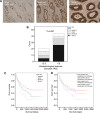Tumour expression of leptin is associated with chemotherapy resistance and therapy-independent prognosis in gastro-oesophageal adenocarcinomas
- PMID: 24569475
- PMCID: PMC3960617
- DOI: 10.1038/bjc.2014.45
Tumour expression of leptin is associated with chemotherapy resistance and therapy-independent prognosis in gastro-oesophageal adenocarcinomas
Erratum in
-
Tumour expression of leptin is associated with chemotherapy resistance and therapy-independent prognosis in gastro-oesophageal adenocarcinomas.Br J Cancer. 2015 Dec 1;113(11):1641. doi: 10.1038/bjc.2015.391. Br J Cancer. 2015. PMID: 26625221 Free PMC article. No abstract available.
Abstract
Background: Cytotoxic chemotherapy remains the main systemic therapy for gastro-oesophageal adenocarcinoma, but resistance to chemotherapy is common, resulting in ineffective and often toxic treatment for patients. Predictive biomarkers for chemotherapy response would increase the probability of successful therapy, but none are currently recommended for clinical use. We used global gene expression profiling of tumour biopsies to identify novel predictive biomarkers for cytotoxic chemotherapy.
Methods: Tumour biopsies from patients (n=14) with TNM stage IB-IV gastro-oesophageal adenocarcinomas receiving platinum-based combination chemotherapy were used as a discovery cohort and profiled with Affymetrix ST1.0 Exon Genechips. An independent cohort of patients (n=154) treated with surgery with or without neoadjuvant platinum combination chemotherapy and gastric adenocarcinoma cell lines (n=22) were used for qualification of gene expression profiling results by immunohistochemistry. A cisplatin-resistant gastric cancer cell line, AGS Cis5, and the oesophageal adenocarcinoma cell line, OE33, were used for in vitro validation investigations.
Results: We identified 520 genes with differential expression (Mann-Whitney U, P<0.020) between radiological responding and nonresponding patients. Gene enrichment analysis (DAVID v6.7) was used on this list of 520 genes to identify pathways associated with response and identified the adipocytokine signalling pathway, with higher leptin mRNA associated with lack of radiological response (P=0.011). Similarly, in the independent cohort (n=154), higher leptin protein expression by immunohistochemistry in the tumour cells was associated with lack of histopathological response (P=0.007). Higher leptin protein expression by immunohistochemistry was also associated with improved survival in the absence of neoadjuvant chemotherapy, and patients with low leptin protein-expressing tumours had improved survival when treated by neoadjuvant chemotherapy (P for interaction=0.038). In the gastric adenocarcinoma cell lines, higher leptin protein expression was associated with resistance to cisplatin (P=0.008), but not to oxaliplatin (P=0.988) or 5fluorouracil (P=0.636). The leptin receptor antagonist SHLA increased the sensitivity of AGS Cis5 and OE33 cell lines to cisplatin.
Conclusions: In gastro-oesophageal adenocarcinomas, tumour leptin expression is associated with chemoresistance but a better therapy-independent prognosis. Tumour leptin expression determined by immunohistochemistry has potential utility as a predictive marker of resistance to cytotoxic chemotherapy, and a prognostic marker independent of therapy in gastro-oesophageal adenocarcinoma. Leptin antagonists have been developed for clinical use and leptin and its associated pathways may also provide much needed novel therapeutic targets for gastro-oesophageal adenocarcinoma.
Figures



References
-
- Abdel-Fatah TMA, Perry C, Dickinson P, Ball G, Moseley P, Madhusudan S, Ellis IO, Chan SYT. Bcl2 is an independent prognostic marker of triple negative breast cancer (TNBC) and predicts response to anthracycline combination (ATC) chemotherapy (CT) in adjuvant and neoadjuvant settings. Ann Oncol. 2013;24 (11:2801–2807. - PubMed
-
- Bang Y, Van Cutsem E, Feyereislova A, Chung HC, Shen L, Sawaki A, Lordick F, Ohtsu A, Omuro Y, Satoh T, Aprile G, Kulikov E, Hill J, Lehle M, Rüschoff J, Kang Y. Trastuzumab in combination with chemotherapy versus chemotherapy alone for treatment of HER2-positive advanced gastric or gastro-oesophageal junction cancer (ToGA): a phase 3, open-label, randomised controlled trial. Lancet Oncol. 2010;376:687–697. - PubMed
-
- Beales ILP, Ogunwobi OO. Leptin synergistically enhances the anti-apoptotic and growth-promoting effects of acid in OE33 oesophageal adenocarcinoma cells in culture. Mol Cell Endocrinol. 2007;274:60–68. - PubMed
-
- Bjorbaek C, Kahn BB. Leptin signaling in the central nervous system and the periphery. Recent Prog Horm Res. 2004;59:305–331. - PubMed
Publication types
MeSH terms
Substances
Supplementary concepts
Grants and funding
LinkOut - more resources
Full Text Sources
Other Literature Sources
Medical

